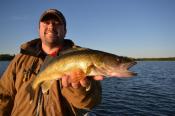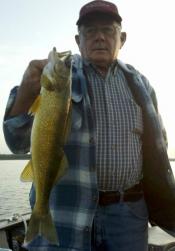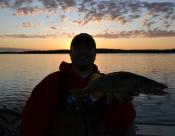 The bite is tough. Food is abundant. Bugs, minnows, hatchlings, and creepy crawlies of all types stock the walleye buffet at your local lake during the dog-days of August. The best days of walleye fishing are behind us….and ahead of us. Choose anytime to fish but August they say. Well I say it too. I’ll be the first to admit that I stack my fishing adventures more heavily towards the early and later parts of the season. But that’s not to say there aren’t fish to be had during this time period. They’re there. Fat and finicky, in fairly predictable locations. The trick isn’t just finding them during this time of year, which can be hard enough for walleyes of any season. This time of year, a premium goes to finding active fish, or fooling inactive ones. Most times it’s a healthy combination of both.
The bite is tough. Food is abundant. Bugs, minnows, hatchlings, and creepy crawlies of all types stock the walleye buffet at your local lake during the dog-days of August. The best days of walleye fishing are behind us….and ahead of us. Choose anytime to fish but August they say. Well I say it too. I’ll be the first to admit that I stack my fishing adventures more heavily towards the early and later parts of the season. But that’s not to say there aren’t fish to be had during this time period. They’re there. Fat and finicky, in fairly predictable locations. The trick isn’t just finding them during this time of year, which can be hard enough for walleyes of any season. This time of year, a premium goes to finding active fish, or fooling inactive ones. Most times it’s a healthy combination of both.
 This past week, I got the chance to fish big and beautiful Leech Lake, as well as a handful of new walleye lakes within an hour’s drive. What we had going for us was fairly stable weather, and more favorably yet, consistent wind. Fish were consistently placed on the west facing portions of every piece of structure we fished, with active and hungry fish waiting face-first on the most prominent piece of that structure, almost without fail. There were some days where we had a bit too much of that west wind, fishing on the east side of Leech lake, so we happily obliged by fishing several other area lakes for walleyes that still sported some walleye-chop, instead of just heavy-chop. As mentioned, finding fish was less difficult for us than finding active fish. We put a heaping handful of offerings in front of many fish these past few days, but got bit only when everything was perfect. Making the stars align meant paying attention to small details that tend not to matter as much when the bite is hot, but were everything in determining our success last week.
This past week, I got the chance to fish big and beautiful Leech Lake, as well as a handful of new walleye lakes within an hour’s drive. What we had going for us was fairly stable weather, and more favorably yet, consistent wind. Fish were consistently placed on the west facing portions of every piece of structure we fished, with active and hungry fish waiting face-first on the most prominent piece of that structure, almost without fail. There were some days where we had a bit too much of that west wind, fishing on the east side of Leech lake, so we happily obliged by fishing several other area lakes for walleyes that still sported some walleye-chop, instead of just heavy-chop. As mentioned, finding fish was less difficult for us than finding active fish. We put a heaping handful of offerings in front of many fish these past few days, but got bit only when everything was perfect. Making the stars align meant paying attention to small details that tend not to matter as much when the bite is hot, but were everything in determining our success last week.
 Leech has always been a great place to pull spinners for me. Vast amounts of structure dictate covering some water. So cover water we did, and harvested waypoints on our traditional milk-runs every time a rod bent over in the holder. The best of the best got a harder look, and we picked apart some more intricate structure slowly with live-bait rigs. Hammered silver and gold with crawlers took most of the spinner fish, and a standard 6-8’ rig with a plain hook and chartreuse bead with half a crawler was the favored rig-offering. 16-22 FOW depending on time of day, with low-light periods seeing most of the fish. Nothing spectacular sounding, but the application was much more difficult than it sounded. Fish were following on the graph, stalking, just waiting for a zag instead of a zig. Holding the rod and imparting some subtle action to the spinners got yours bit 2 to 1 over leaving it in the holder.
Leech has always been a great place to pull spinners for me. Vast amounts of structure dictate covering some water. So cover water we did, and harvested waypoints on our traditional milk-runs every time a rod bent over in the holder. The best of the best got a harder look, and we picked apart some more intricate structure slowly with live-bait rigs. Hammered silver and gold with crawlers took most of the spinner fish, and a standard 6-8’ rig with a plain hook and chartreuse bead with half a crawler was the favored rig-offering. 16-22 FOW depending on time of day, with low-light periods seeing most of the fish. Nothing spectacular sounding, but the application was much more difficult than it sounded. Fish were following on the graph, stalking, just waiting for a zag instead of a zig. Holding the rod and imparting some subtle action to the spinners got yours bit 2 to 1 over leaving it in the holder.
 Details were more important yet on the other lakes. You come to take for granted the high-resolution Lakemaster contours when you fish big bodies of water most often. Going to a lake that hasn’t been surveyed at all makes you feel a bit naked at first, but there’s ways to overcome that as well. With smaller lakes comes less open water for there to be off-shore structure. That being the case, most of our fish held to what structure was there, namely underwater points extending from shore with the most productive ones not necessarily following the outline of the shore itself. Read that as underwater points that extended from a rather straight and featureless piece of shoreline. These are the ones that are harder for everyone else to find, so they’re the most valuable. However, using your electronics at high speed (25-35mph on my boat), cruise off of shore in 18-24 FOW, looking for the bottom to rise and bottom color to indicate hard bottom. Drop a waypoint and continue on your way until you’ve “mapped” the irregular structure. Come back and sweep it in all directions with your electronics, looking for pods of fish and the way this structure lays out, paying particular attention to windblown portions of the structure, as well as small irregular portions of the structure itself. These small areas on the larger underwater points were gold mines for us, but fell more into the “have-to-trick-them” category than the “pick-off-the-active-fish” one. Not all pieces of structure are created equal, and here’s where the Marcum 620 came in handy. Where there were other signs of life, walleyes were there aplenty. Clam shells, crayfish, minnows, perch…..all were indicators of the walleyes we knew we’d catch. Some of the most beautiful looking rock/sand/mud transitions that were lifeless held none.
Details were more important yet on the other lakes. You come to take for granted the high-resolution Lakemaster contours when you fish big bodies of water most often. Going to a lake that hasn’t been surveyed at all makes you feel a bit naked at first, but there’s ways to overcome that as well. With smaller lakes comes less open water for there to be off-shore structure. That being the case, most of our fish held to what structure was there, namely underwater points extending from shore with the most productive ones not necessarily following the outline of the shore itself. Read that as underwater points that extended from a rather straight and featureless piece of shoreline. These are the ones that are harder for everyone else to find, so they’re the most valuable. However, using your electronics at high speed (25-35mph on my boat), cruise off of shore in 18-24 FOW, looking for the bottom to rise and bottom color to indicate hard bottom. Drop a waypoint and continue on your way until you’ve “mapped” the irregular structure. Come back and sweep it in all directions with your electronics, looking for pods of fish and the way this structure lays out, paying particular attention to windblown portions of the structure, as well as small irregular portions of the structure itself. These small areas on the larger underwater points were gold mines for us, but fell more into the “have-to-trick-them” category than the “pick-off-the-active-fish” one. Not all pieces of structure are created equal, and here’s where the Marcum 620 came in handy. Where there were other signs of life, walleyes were there aplenty. Clam shells, crayfish, minnows, perch…..all were indicators of the walleyes we knew we’d catch. Some of the most beautiful looking rock/sand/mud transitions that were lifeless held none.
Live bait rigging, slowly was the key to success on these lakes. 0.3mph, long snells (8-10 feet), small plain colored hooks, with lively leeches were all essential parts of the game. Miss one of the above and you might as well be fishing for walleyes in the Pacific. We tried bobbering on the fish, but they were so concentrated, they were actually easier to find by dragging slowly in a small area till you connected. Small turns of the boat, where the inside rod literally paused in place got the majority of the bites. Fish chased here too, and imparting some action on the bait was more productive that the basic motionless hold that’s more common. Bites were basically phantom. Most were just light pressure, almost like a snag. Pick up the sinker slowly until the hook either gave from the rock it was on, or gently tugged back. Drop the sinker in the rocks and you’d sometimes spook the fish. Set it down gently, give the fish a 5-count and sweep, and you were usually rewarded. Again, low-light periods saw most of the fish, and also particular zones of activity. Catch them on their climb out of the depths at dusk, or on the retreat back at dawn, and you’d connect in 17-20 FOW. Too early or too late, and they’d be shallower or deeper; and MUCH more reluctant to bite.
So there you have it. Lots of fun, and plenty of fish to be had, with just a few more details making the difference between bit or bummed.
Joel